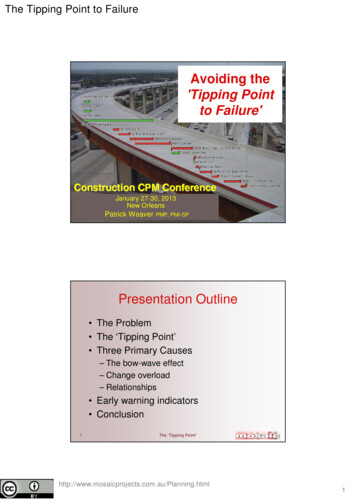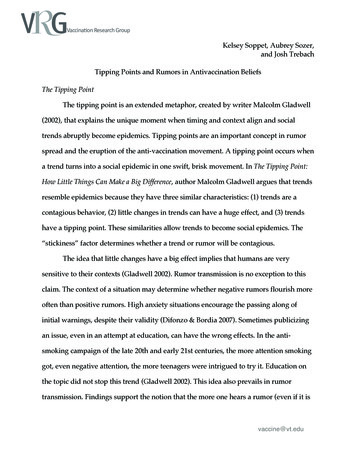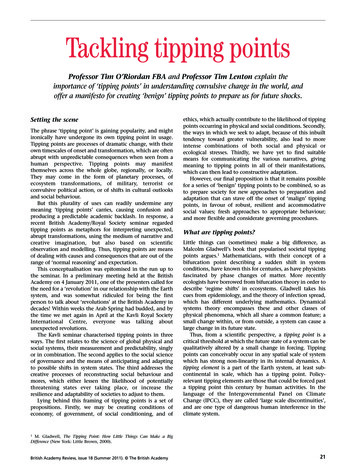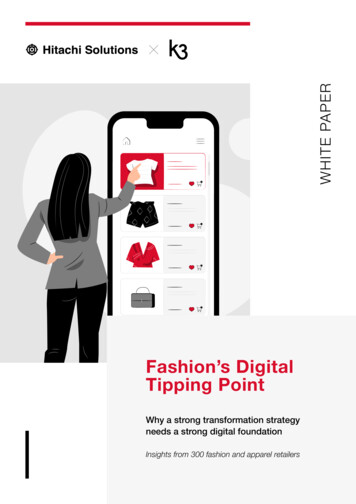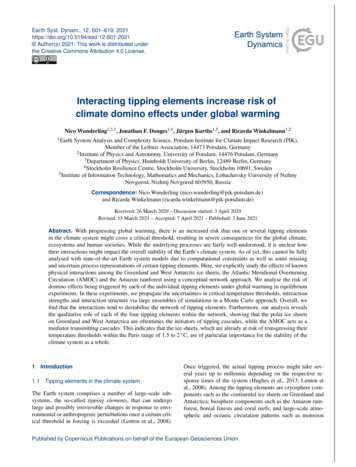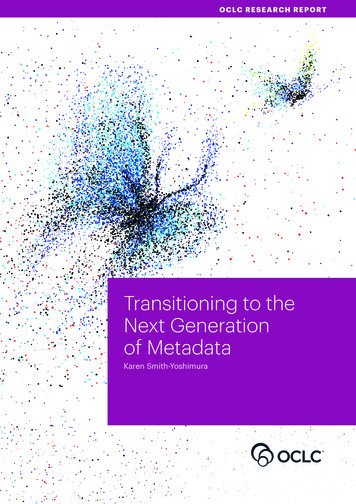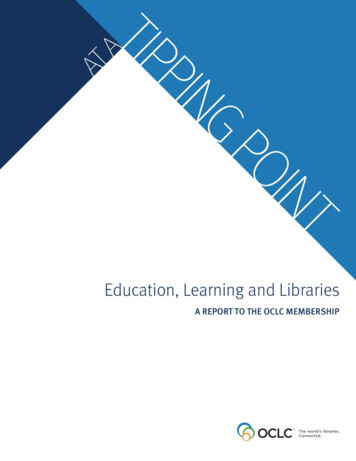
Transcription
AT ATIPPINGPOINTTABLE OF CONTENTSAt a Tipping Point:Education, Learning and LibrariesA REPORT TO THE OCLC MEMBERSHIPAT A TIPPING POINT: Education, Learning and Libraries1
AT ATIPPINGPOINTAT A TIPPING POINT: Education, Learning and LibrariesTABLE OF CONTENTS2
AT ATIPPINGPOINTTABLE OF CONTENTSAt a Tipping Point:Education, Learning and LibrariesA REPORT TO THE OCLC MEMBERSHIPPrincipal contributorsCathy De Rosa, MBA, Vice President for the Americas and Global Vice President of MarketingJoanne Cantrell, Marketing AnalystPeggy Gallagher, MLS, MMC, Manager, Market AnalysisJanet Hawk, MBA, Director, Market Analysis & Sales ProgramsIrene Hoffman, MLS, Executive Director, Member RelationsReneé Page, Design LeadContributorsLorraine Haricombe, PhD, Dean of Libraries, University of KansasDeb Wallace, PhD, Executive Director of Knowledge & Library Services, Baker Library,Harvard Business SchoolEditing and Research AssistanceSusan Colchin, Market Intelligence AnalystTam Dalrymple, MLS, Senior Information SpecialistBrad Gauder, EditorOCLCDublin, Ohio USAAT A TIPPING POINT: Education, Learning and Libraries3
AT ATIPPINGPOINTTABLE OF CONTENTSCopyright 2014 OCLC Online Computer Library Center, Inc.6565 Kilgour PlaceDublin, Ohio 43017-3395ALL RIGHTS RESERVED. Graphics appearing in the report and excerpts of text from the report may be reproduced by libraryorganizations and OCLC member libraries for their noncommercial use without the prior written permission of OCLC, providedthat such use is accompanied by clear and full attribution to OCLC (see format below) and proper acknowledgment of any workscited by OCLC in the graphics or excerpts used. Neither the full report nor complete chapters from the report may be reproduced,republished, stored in a retrieval system, transmitted or otherwise used, in any form or by any means, without the prior writtenpermission of OCLC. Please direct permission requests to membershipreports@oclc.org.Form of attribution to OCLC: “OCLC, At a Tipping Point: Education, Learning and Libraries, 2014.”The following are trademarks and/or service marks of OCLC Online Computer Library Center, Inc.: OCLC, the OCLC logoand WorldCat.Third-party product, service and business names are trademarks and/or service marks of their respective owners.Photography and art are copyright of their respective sources:iStockphoto.com: 88, 89ThinkstockPhotos.com: 8, 13, 14, 15, 16, 18, 19, 20, 21, 25, 26, 29, 37, 39, 41, 45, 46, 47, 49, 51, 52, 54, 55, 59, 60, 61,62, 63, 64, 65, 69, 70, 71, 73, 77, 83, 90, 91, 92, 93, 94, 105TheNounProject.com: 14, 15, 16, 25, 73, 97CreativeMarket.com: 13, 17, 32, 94Printed in the United States of AmericaCataloged in WorldCat on June 18, 2014OCLC Control Number: 881472162ISBN: 1-55653-478-7978-1-55653-478-215 14 13 12 11 10 1 2 3 4 5 6AT A TIPPING POINT: Education, Learning and Libraries4
AT ATIPPINGPOINTTABLE OF CONTENTStable of contentsAt a Tipping Point 3Introduction 5CHAPTER ONEChapter FIVELearning Online: Participation and Perceptions 13Who are the Online Learners? 14Education at a Tipping Point 79Research Summaries 80Learning on Our Mobile Devices 17Online Learning is Meeting a Need Taking Online Classes and MOOCs 18Online Learning is Life-based Learning MOOCs – Massively Interesting 24MOOC Goals are Met 26Online Learning: A Positive Experience 27Online Learning—the Best is Yet to Come 30MOOCs: A Case Study on the Future of Education 83A Cost/Value Imbalance 40Making a Choice – College Decision Criteria 44Weighing the On-campus or Online Experience 46Chapter THREELibraries: The Brand 50My Most Recent Library Experience 54Context 55Chapter FourPerceptions: Campus Life and Libraries 59Perceptions of Campus Life 60The Library’s Territory on Campus 65Perceptions of the Campus Library 67Online Learners and Using the Library 73Finding and Using the Library Website 75What Online Learners Want 77AT A TIPPING POINT: Education, Learning and Libraries84The Marketing of MOOCs 85Libraries at a Tipping Point 49The Library Brand MOOCs: Massively Interesting LearningLaboratories Chapter SIXHigher Education: Perceptions and Choices 373981The Library is Books.and a Place to Get Work Done 82Chapter TWOPerceptions of a College Education 801i87Tipping Points are Opportunity Points 88What Online Learners Need 90Resetting the Context, Reframing the Library 91A Tipping Point is Coming to Education 96Appendices 99Appendix A: Methodology 99Appendix B: OCLC Research Reports 107Appendix C: Sources Consulted 109
AT ATIPPINGPOINTAT A TIPPING POINT: Education, Learning and LibrariesTABLE OF CONTENTS2
POINTTIPPINGAT AAT ATIPPINGPOINTWe are quickly approaching the tipping point into a new future for American education.This transformation follows tipping points that have already occurred in how most of us consume andevaluate information, how we shop and buy, how we date and break up, and how we manage our careersand our retirement portfolios. Web and mobile services have forever changed how we manage our days,our jobs, and very soon, how we learn and manage our education.We now spend nearly as much time exploring online, watching videos on our mobile phones, texting andtweeting each day as we do sleeping. So every day, keystroke by keystroke, click by click, we become moreskilled, more confident and more empowered.It should not come as a surprise then that the skills and talents that we have already unleashed on somany aspects of our lives would come to guide how we learn and educate ourselves. It is simply ‘what’snext’ in our digital evolution.Yet, as is often the case in times of change, many of the primary purveyors of the traditional services thatare being reshaped, or more likely unseated, don’t see the shift coming. Perhaps we are too close forproper viewing or too comforted by loyal customers and high customer service ratings; we don’t feel thetip or sense shifts in the landscape. We misread the cues.This impending education tipping point is not the result of any single event or set of new services. It isnot the result of the recent appearance of one online education model, MOOCs. It is not the result ofan outcry of parents, looking for alternatives to what many are calling “unfundable college educations.”Nor is it because of the rise of easy-to-use self-help videos and tutorials. Education will tip into a newfuture because of the cumulative weight of all of these factors—new consumer practice, evolvingtechnological capabilities and increasing economic incentives.As social scientist Malcolm Gladwell tells us, “A tipping point is that magic moment when an idea, trendor social behavior crosses a threshold, tips and spreads like wildfire.”The sparks are visible.AT A TIPPING POINT: Education, Learning and Libraries3
AT ATIPPINGPOINTSo, what is it that we are tipping toward? We are tipping from the age of students as directed learnersto an era of students as empowered education consumers and eager education evaluators. We aretipping toward an educational era of choice over tradition, convenience over perfection, self-service overpredefined options. Ratings, recommendations, just-in-time delivery—every facet of digital life—will cometo bear on education. We will change how we learn, where we learn and who guides our path. Just as wehave trip advisors, we will have online education advisors, e-books and e-courses, self-service and selfpaced, on-campus and on-demand. We will have options.And we will need libraries—prepared to support the needs and aspirations of online learners.The same digital forces reshaping education will reshape libraries, on our campuses and across ourcommunities. But even if libraries are ready, will education consumers seek out libraries? Will librariesmiss the cues? The brand perception of libraries remains firmly planted in tradition. Libraries books.This latest OCLC research study aims to provide librarians with important information about the trendsand triggers that are driving to this tipping point. We will share data on consumers’ attitudes about highereducation and about their use, perceptions and future expectations of online learning and MOOCs. We willshare data about parents’ and students’ perceptions of campus life and campus libraries, and what they knowand like about online learning. And we will share what they told us about the library’s role in online learning.The strategy question that I hear most when I speak with library leaders is, “Are we acting quickly enough,and boldly enough, to do what it takes to remain relevant?”What are the most effective strategies to gain—and to communicate—the relevance of libraries with thetip to a new era of education? We conclude this report with some thoughts for strategic consideration andfor immediate action. We lean on the work of David Allen Aaker, an expert who has spent a career studyinghow successful organizations build, sustain and communicate brand relevance in a changing world.We benefited from the talents and expertise of two extraordinary library leaders to prepare this study.Special thanks to colleagues Lorraine Haricombe, Dean of Libraries at the University of Kansas, and DebWallace, Executive Director of Knowledge & Library Services at the Baker Library, Harvard Business School,for their insights, guidance and support in this research.As always, the aim of this report to the OCLC membership is to share data about the trends that will shape ourcollective future. A new future is coming to education—and libraries. The sparks are visible. It’s time to act.Cathy De RosaVice President for the Americas andGlobal Vice President of MarketingOCLCAT A TIPPING POINT: Education, Learning and Libraries4
AT ATIPPINGPOINTINTRODUCTIONWe are a nation of confident, empoweredonline information consumers who arealways ‘on.’ Soon we will be a nationof confident, empowered onlineeducation consumers.A few years ago, we would have beencomfortable making such predictionsfor the younger segment of the U.S.population, the early social mediaadopters, the digital natives. But thatqualifier is no longer needed. Affordablesmartphones, free Wi-Fi hotspots,texting and YouTube have leveled theplaying field and the learning field.Across all age groups, income levelsand education levels, we are an onlinenation—ready and eager to embraceonline education.The OCLC Market Research teamhas been studying the ‘informationconsumer,’ a term we first used in 2003,for over a decade. We have trackedinformation consumers’ behaviors,perceptions and attitudes—how theyfeel about and use online information,search engines, Amazon, Google,libraries and library websites.INTRODUCTIONR U online?Always unless I’m sleepingI know right?Love my new smartphone. My lifeline!Jealous! Can’t afford a new oneJust saw u can get one free onlineProbably a scamDoubt it - saw it on 3 or 4 sitesHmm did u get your tablet replaced?No. Not happy! Did u see my tweet?Yeah. Could tell u r not happy! :(No for new one! I need a promotion or a new careerGo back to school!!!College is soooo Do it online. Should be cheaperTrue. I’d wanna be on campus, too. Hang out, meet people,check out the libraryThe library? Really?Sure! I’ve always loved the library. Went all the timewhen I was littleBack when we had time to read a book, huh?LOL. So, I should try online classes?Definitely! Loved the online class I took!Gotta go. TTYLAT A TIPPING POINT: Education, Learning and Libraries5
AT ATIPPINGPOINTINTRODUCTIONSince the launch of the social Web, wehave tracked how online users viewprivacy and security and how theyview and use their social networks.Information consumers have sharedwhat they like and believe, and whatthey expect to use more in the future.“[I’m] becoming familiarwith the computer, the artof conversation online asopposed to in person.”MOTHER OF A HIGH SCHOOL STUDENT, Age 52We have seen some significant changes(e.g., who is spending time online), andwe have seen some things not changemuch at all (e.g., perceptions of libraries).In 2005, when we published the firstPerceptions of Libraries and InformationResources, about 70% of Americanswere online. Today, that rate has grown to87%, including more than half of thoseover the age of 65 (Pew, January 2014c).In that same time period, cell phoneownership rose from about 70% in2005 to 90% in 2014, and more thanhalf (58%) now own a smartphone(Pew, January 2014b).In 2007, when we published Sharing,Privacy and Trust in our NetworkedWorld, 71% of those under 25 werealready using social networking sites,most logging on daily to their favoritesite. But only 13% of those age 60 wereengaged in social networking activities.social networking by 10%0%AGE 24 oryoungerToday, 94% of those under 25 usesocial networking sites; so do 60% ofthe 60 age group, with 32% visitingFacebook daily.AT A TIPPING POINT: Education, Learning and Libraries20146AGE25–35AGE36–50AGE51–59AGE60
AT ATIPPINGPOINTINTRODUCTIONThe gap is also closing across incomeand education levels.In 2007, those with household incomesof less than 25,000 had highersocial networking participation ratesthan other income levels. That trendcontinues in 2014, but the gap inparticipation rates between incomelevels has gotten smaller.social networking by INCOME2007100%90%82%80%81%76%70%72%60%50%In 2007, education level said a lot aboutwho was on social networking sites—much less so today. High school studentsin 2007 were by far the segment whowere most likely to use social networkingsites. Today, high school student useexceeds 90%. Roughly three quartersof adults with or without any post-highschool education are now participatingin online social networks.40%Equipped with mobile and tablettechnology and thousands of socialsites, all ages, income and educationlevels are now connected and activeparticipants on the social Web. They areprepared and eager to embrace moreonline services and lifestyle changes.100%Online education is next.201430%20%10%0%Less than 25,000 25,000– 49,999 50,000– 99,999 100,000 social networking by 40%30%20%10%0%AT A TIPPING POINT: Education, Learning and LibrariesCUrRentHigh SchoolStudent7HighSchoolDegree orLessSomecollege ortrainingafter eGraduatework ordegree
AT ATIPPINGPOINTINTRODUCTIONAmerica is now an online nation, prepared and eager to adopt more and more virtual services that canimprove lives, offer new convenience or bring economic value. These opportunities exist in education.Articles and exposés talk about the soaring cost of postsecondary education, performance declines inelementary education, the need to retool the nation’s workers for next-generation jobs, and baby boomers’desire to stay connected, engaged and involved post-retirement. All of these factors support the need formore, different and versatile forms of education. Likewise, this diverse set of community needs, alreadyplacing new demands on academic and public libraries, will only increase, while the budgets to supportthese needs will not.How will shrinking budgets, mobile and Internet technology, and shifting consumer attitudes and needsspur on changes in education and library services?Once again, we reached out to information consumers to see what they had to say. In this report, we bringtogether a decade of consumer trend analyses, updated with new data from two recent studies: Findings compiled from a survey of 3,700 U.S. online information consumers of all ages about theirperceptions and attitudes on college, the cost of education, online learning and libraries; A unique study of 1,600 U.S. college parents and alumni who shared their attitudes and beliefs aboutthe various services and facilities that make up the on-campus college experience—and the distinctiverole that libraries play in that experience.The research suggests that information consumers are skilled, equipped and incented to adopt newservices that can bring convenience and flexibility to how they learn. They are actively engaged in onlinelearning, and they like what they see. They anticipate that learning online will improve in quality andincrease in popularity. They see a shift coming to education—and coming soon.Economics, smartphones, tablets andan empowered online student bodywill fuel rapid change to traditionaleducation and learning.The ‘information consumer’is becoming the‘online education consumer.’AT A TIPPING POINT: Education, Learning and Libraries8
AT ATIPPINGPOINTINTRODUCTIONBut how swift and how disruptive will the shift be?Traditional education providers have not been as eager to declare the coming radical change to campusbased education. Most professional educators and administrators would likely agree that changes inpedagogy and technology will shape the future of education, but many have spoken out to assert that thetiming and extent of changes will not be as fast or as radical as some technology providers declare.The debate has been fueled by the recent and rapid rise of perhaps the most radical alternative totraditional education in 200 years, the MOOC—massive open online course. MOOCs have been centerstage at conferences, on blogs and in the press for more than two years. MOOC enthusiasts tout reach andcommunity, critics cite MOOCs as interesting but lacking compelling results and with low completion rates.“For every 100 pupils who enrolled in a free course, something like five actually learned the topic. If thiswas an education revolution, it was a disturbingly uneven one” (Chafkin, 2013).Point taken. When it comes to estimating the maturation rate of new technologies, we are often overlyambitious—think electric cars first conceived in the 19th century and the first e-book reader introduced (tolittle acclaim) a decade before the Kindle (which sold out within hours of hitting the market).Gartner, a global information technology research firm,developed The Gartner Hype Cycle in 1995 as a strategy andplanning tool, now regularly used by managers to track theadoption rate of new technologies.The hype cycle recognizes that a technology trigger oftenlaunches new services into a market. Excited consumers andtechnologists can raise the new services or products to alevel of inflated expectation. When the expectations are notmet quickly enough, a period of disillusionment follows. Ifsuccessful, the new (or no longer new) technology survivesand evolves to reach market success. Most technologies,including online learning platforms and MOOCs, mustnavigate through these stages.AT A TIPPING POINT: Education, Learning and Libraries9Gartner Hype CycleAttribution: Gartner, Research Methodologies, Hype ethodologies/hype-cycle.jsp
AT ATIPPINGPOINTINTRODUCTION“We always overestimate the change that will occur in the next two years and underestimatethe change that will occur in the next ten. Don’t let yourself be lulled into inaction.”—Bill Gates, The Road AheadSo, are we overzealous about how new technologies will change education? Or, are we missingimportant clues that indicate that we are moving with haste through the adoption cycle, ready to seewidescale adoption of new learning practices that will change how educators and librarians manage?We need to look beyond the technology hype to answer the question.It takes more than a new technology to create a tip. Other forces must come to bear to overcome thegravitational pull of well-established educational practice and institutional structure.For a tip to come to the education market, or to drive mass change in any well-established market,three forces of change must align: Consumer Behavior. Effective Technology. Economic Incentive.Forces of changeBEHAVIOR1. Consumer Behavior.2. Effective Technology.ECONOMICS3. Economic Incentive.GYNOLOTECHMarkets tip when3 factors come into alignment:Data collected from this study, taken together with other recent consumer research and online learningplatform usage statistics, provide compelling evidence of pressure along all three dimensions needed tocreate a tip. Empowered consumer behavior, effective technology tools and economic incentives are allpressing in the same direction—toward a new future for education and learning.AT A TIPPING POINT: Education, Learning and Libraries10
AT ATIPPINGPOINTINTRODUCTIONForces of ChangeBehaviorInformation consumers have amassed significant online and self-service skills. Internet use is nearlyubiquitous across ages, income and education levels. Information consumers spend 5 hours online everyday, shopping, socializing and learning (eMarketer, April 2014). The do-it-myself, at-my-pace, on-my-deviceapproach to service has already supplanted many traditional face-to-face services from depositing checks torenewing automobile license plates. Online recommendations from a trusted source, a friend or a colleagueare fueling new product trials and accelerating adoption of services and new buying behaviors.TechnologyPrices for smartphones and tablets have been reduced, leading to mass market adoption. Since 2010,the average price of an iPad has dropped 48% (Newman, 2013). Tablet ownership is expected to grow bynearly 40% this year (Attard, 2014). Robust Internet access has helped to make YouTube the second mostused (46% visiting daily or weekly) online social networking service behind Facebook (67% visiting dailyor weekly). The learning platforms fueling the rise of MOOCs are still in early stages, but today are ableto support class sizes of 20,000 and hundreds of course offerings. The technologies required to poweronline education are here or on the horizon.EconomicsThe average annual price (including tuition, fees, room and board) for a U.S. four-year, in-state publiccollege education was 17,474 in 2012-13 (NCES, Table 330.20, 2014). Assuming it takes four years tograduate, that is nearly a 70,000 investment. Over the last ten years, increases in college costs outpacedthe inflation rate. Cost is the first thing that parents think of when they think about a college education.Affordability is the top factor for parents and students when choosing a college. College students areconcerned about costs and most believe online education will decrease the cost of higher education.The forces for change—behavior, technology, economics—are in alignment. A tipping point isnear for education—and for libraries.AT A TIPPING POINT: Education, Learning and Libraries11
AT ATIPPINGPOINTINTRODUCTIONAbout this report:Chapter One provides data about progress achieved with online learning. Information consumers arequickly adopting online learning for degrees, work advancement and self-enrichment. We will sharewhat we learned about online learning models, including MOOCs, along with information consumers’impressions, their perceptions of online education today, and what they expect in the future.Chapter Two explores attitudes about postsecondary education. We share data about what informationconsumers have to say about the cost and value of a college education. Students and parents provideinsights into their selection and evaluation of the education experience—what they want and what theycan afford.Chapters Three to Six explore implications for the library.Chapter Three returns to a conversation we have been exploring for some time—the library brand. Whatdo users think about when they think about the library in 2014? What changed and what did not? Weexplore new opportunities and new challenges for the library brand as the information consumer adoptsnew online learning skills and attitudes.Chapter Four explores the library’s role in the on-campus experience. Using a perceptual mappingresearch technique, we map the beliefs of college parents and alumni to better understand their attitudesabout the college experience and the library’s role. The unique, and the not-so-unique, roles that campuslibraries play in the overall education experience are uncovered. And we explore the early experiencesthat learners are having with the library while taking online classes.Chapter Five provides a summary of what the research revealed about learners and libraries. Acase study of the impact of MOOCs, and how they are applying the “immutable laws of marketing,”principles of marketing success established by Al Ries and Jack Trout, to change users’ perceptions ofeducation, is presented.Chapter Six summarizes the considerations and challenges for librarians as they prepare to support theonline education consumer. We return to the discussion of the library brand and identify steps to taketoday to adapt and energize the brand and increase the relevance of libraries.AT A TIPPING POINT: Education, Learning and Libraries12
AT ATIPPINGPOINTCHAPTERONECHAPTER ONE: Learning Online: Participation and PerceptionsLearning Online: Participation and Perceptions“The most beneficial experiencesof online learning are probably theflexibility of the schedule and thefact I can go to class in my pajamas.”“Knowledge is power.I have benefited manytimes from online learning.”MOTHER OF A COLLEGE STUDENT, Age 43COLLEGE STUDENT, FEMALE, Age 18We are enriching our lives online. We work, shop, bank, andsocialize online. And we are learning online. Just under half ofthe online population have participated in online learning—enrolling in online degree classes and taking non-degreeclasses or watching tutorials to improve work and life skills.Who are today’s online learners? What types of online classesare they taking? What are their goals for taking online classes?Are their goals being met? What do they think about thequality of their learning experiences? What are their thoughtsabout MOOCs and the future of online learning? Chapter Oneaddresses these questions.In this chapter: A profile of the online learner Online learning is going mobile Top goals for online learning arebeing met MOOCs – Massively interesting Convenience trumps all otherbenefits of online learning 8 out of 10 recommendonline learning Self-discipline is challenging forlearners, both in the classroomand online Online learning is expected to onlyget better and more popularAT A TIPPING POINT: Education, Learning and Libraries13
AT ATIPPINGPOINTCHAPTER ONE: Learning Online: Participation and PerceptionsWho Are the Online Learners?Nearly half of online Americans haveparticipated in some type of onlinelearning activityNearly half (48%) of the online population ages 16 and olderhave participated in online learning. They are participating inmultiple online learning opportunities, using a variety of tools.Participation ranges from taking an online class for degreecredit at a traditional or online-only college, or taking onlinenon-degree classes or tutorials for work, continuing educationor for personal growth (e.g., learning a language, developingcomputer skills, taking up a new hobby, etc.).Benefiting from online skills honed by using other consumeror social-networking services, learners are showing a strongappetite and satisfaction level with online learning. Today, wesee online learners spanning all age groups, income levelsand education levels.ALL AGE GROUPSAll ages have taken online classes or tutorialsTotal respondents 48%70%Online learners cannot be characterized by agedemographics. Our survey revealed that whilethe 25–35 age group has the highest percentageof online learners, all ages have participated inonline learning. Some 40% of respondents ages51 or older have taken a class 24AGE25–35AGE36–50AGE51–59AGE60 Have taken an online class or tutorial.AT A TIPPING POINT: Education, Learning and Libraries14
AT ATIPPINGPOINTCHAPTER ONE: Learning Online: Participation and PerceptionsALL income levelsonline learners across all income levelsTotal respondents 48%70%Adoption of online learning is strong across allincome levels. Top-end income earners havethe highest percentage who are learning online,but very little difference in participation is notedacross income levels less than 100,000 annually.Individuals in households earning less than 25,000are just slightly less likely to participate in onlinelearning than those earning 25,000 to 100,000.59%60%50%42%40%45%45% 25,000– 49,999 50,000– 99,99930%20%10%0%less than 25,000 100,000 Have taken an online class or tutorial.Half or more with post-high school education areOnline LearnersAll education LevelsTotal respondents 48%70%Learners across all education levels are usingonline learning to continue to build their skillsor strengthen their interests. Forty-four percent(44%) of high school students have taken anonline class. Half or more of adults who have atleast some post-high school education have takenan online class, and 27% of adults with a highschool education or less are also participating inonline learning.58%60%57%63%48%50% 44%40%27%30%20%10%0%CurrenthighschoolstudentsSome Associate’s Bachelor’s SomeHighDegree Graduateschool college or Degreedegree trainingwork oror less after highdegreeschoolHave taken an online class or tutorial.more time spent online, more learning onlineALL Levels of internet USETotal respondents 48%70%At least a third of the online population—eventhose who are online the fewest hours each week—are taking online classes. Not surprisingly, themore time they spend online, the more likely theyare to participate in online learning. Experiencebreeds comfort, skills and usage.60%51%50%40%30%57%31%20%10%0%0–7 hrs8–21 hrs22 hrsHOURS PER WEEK onlineHave taken an online class or tutorial.AT A TIPPING POINT: Education, Learning and Libraries15
AT ATIPPINGPOINTCHAPTER ONE: Learning Online: Participation and PerceptionsEarly adoption patterns of online learning show some interesting differences when compared withthe adoption patterns of other online services such as social networking. Our research identified widedifferences
TIPPING POINT Te o oeS AT A TIPPING POINT: education, learning and libraries 1 AT A TIPPING POINT 3 INTRODUCTION 5 CHAPTER ONE Learning Online: Participation and Perceptions 13 Who are the Online Learners? 14 Learning on Our Mobile Devices 17 Taking Online Classes and MOOCs 18 MOOCs - Massively Interesting 24 MOOC Goals are Met 26
